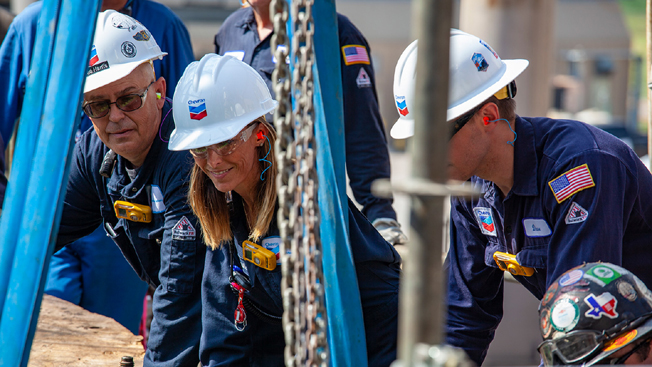
- Reported earnings of $3.5 billion; adjusted earnings of $3.8 billion
- Returned $6.9 billion cash to shareholders; acquired $2.2 billion of Hess shares
- Started production from Ballymore field in the Gulf of America in April
Chevron Corporation reported earnings of $3.5 billion ($2.00 per share - diluted) for first quarter 2025, compared with $5.5 billion ($2.97 per share - diluted) in first quarter 2024. Included in the quarter was a net loss of $175 million related to legal reserves and a tax charge due to changes in the energy profits levy in the United Kingdom that were partially offset by the fair value measurement of Hess Corporation shares. Foreign currency effects decreased earnings by $138 million. Adjusted earnings of $3.8 billion ($2.18 per share - diluted) in first quarter 2025 compared to adjusted earnings of $5.4 billion ($2.93 per share - diluted) in first quarter 2024. See Attachment 4 for a reconciliation of adjusted earnings.

“This quarter reflected continued strong execution and progress on our objective to deliver superior shareholder value,” said Mike Wirth, Chevron’s chairman and chief executive officer. Over the last three years, Chevron has returned more than $78 billion of cash to shareholders. “Despite changing market conditions, our resilient portfolio, strong balance sheet, and consistent focus on capital and cost discipline position us to deliver industry-leading free cash flow growth by 2026.”
In Kazakhstan, following the completion of the Future Growth Project (FGP) at the company’s Tengizchevroil (TCO) affiliate, production ramped up to name-plate capacity. In the United States, Permian Basin production grew with increased efficiencies, first oil was recently achieved on the Ballymore project in the Gulf of America on time and on budget, and the company sold a majority interest in its East Texas gas assets.
Financial Highlights
- Reported earnings decreased compared to last year primarily due to lower income from upstream and downstream equity affiliates, lower margins on refined product sales, unfavorable swings in tax items and foreign exchange effects, and lower realizations.
- Worldwide production was relatively flat from a year ago as the impacts of asset sales were mostly offset by growth at TCO (20 percent), in the Permian Basin (12 percent), and in the Gulf of America (7 percent).
- Capex in the first quarter of 2025 was lower than last year as the inorganic investment in power solutions for U.S. data centers was more than offset by lower spend in downstream. Affiliate capex was down primarily due to lower spend at TCO.
- Cash flow from operations was lower than a year ago mainly due to lower earnings and tax payments related to the Canadian asset sale that closed in fourth quarter 2024, partially offset by higher cash distributions from TCO.
- The company returned $6.9 billion of cash to shareholders during the quarter, including share repurchases of $3.9 billion and dividends of $3.0 billion.
- The company’s Board of Directors declared a quarterly dividend of one dollar and seventy-one cents ($1.71) per share, payable June 10, 2025, to all holders of common stock as shown on the transfer records of the corporation at the close of business on May 19, 2025.
Business Highlights and Milestones
- Acquired 4.99 percent of Hess Corporation (Hess) common stock, reflecting continuing confidence in the consummation of the pending acquisition of Hess.
- Started production from the Ballymore field in the deepwater Gulf of America in April 2025, the latest in a series of project startups over the last year that are expected to increase our production to 300,000 barrels of net oil equivalent per day from the Gulf in 2026.
- Completed the sale of the company’s majority interest in East Texas gas assets for cash and multi-year capital carry, while retaining an overriding royalty interest.
- Completed the sale of certain non-operated U.S. midstream pipelines and facilities in April 2025 and received proceeds from the sale of assets in the Republic of Congo.
- Discovered oil at the non-operated Far South prospect in the deepwater Gulf of America in April 2025.
- Announced a simplified organizational structure to enable more effective execution, as part of the program that is targeted to reduce structural costs by $2-3 billion by the end of 2026.
US Upstream
- U.S. upstream earnings were lower than the year-ago period primarily due to higher operating expenses, including a legal reserve, and lower liquids realizations, partly offset by higher natural gas realizations.
- U.S. net oil-equivalent production was up 63,000 barrels per day from a year earlier primarily due to higher production in the Permian Basin and Gulf of America, partly offset by lower production in the Rockies.
International Upstream
- International upstream earnings were lower than a year ago primarily due to lower liftings, lower affiliate earnings at TCO largely due to higher depreciation, depletion and amortization partly offset by higher production following FGP start-up, lower realizations, and unfavorable swings in tax items and foreign exchange effects, partly offset by lower operating expenses mainly from asset sales.
- Net oil-equivalent production during the quarter was down 56,000 barrels per day from a year earlier primarily due to asset sales in Canada and Republic of Congo, and withdrawal from Myanmar, partly offset by higher production in Kazakhstan following the start-up of the FGP at TCO.
U.S. Downstream
- U.S. downstream earnings were lower than the year-ago period primarily due to lower margins on refined product sales and a legal reserve.
- Refinery crude unit inputs increased 16 percent from the year-ago period primarily due to improved refinery reliability at the El Segundo, California refinery, the absence of a planned shutdown at the Pascagoula, Mississippi refinery, and increased capacity at the Pasadena, Texas refinery upon completion of the Light Tight Oil project.
- Refined product sales increased 4 percent compared to the year-ago period primarily due to higher demand for gasoline.
International Downstream
- International downstream earnings were lower compared to a year ago primarily due to lower margins on refined product sales and less favorable foreign currency effects.
- Refinery crude unit inputs decreased 5 percent from the year-ago period primarily due to a planned turnaround at the GS Caltex refinery in South Korea.
- Refined product sales decreased 2 percent from the year-ago period.
KeyFacts Energy: Chevron US country profile
 KEYFACT Energy
KEYFACT Energy